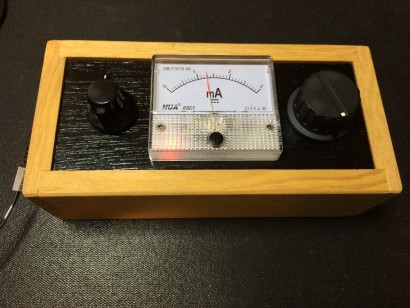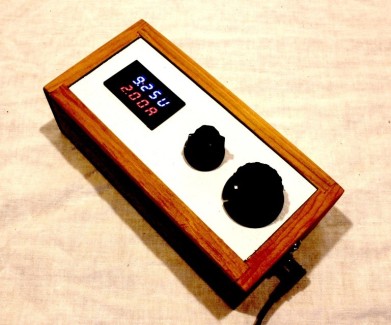Introduction
It’s been a very busy summer and I’m long overdue in writing a review of Super Specific Devices (SSD) line of tDCS* equipment targeting the DIY marketplace. SSD has been quietly building some high-quality gear for several months now and their various models deserve a good look.

(The SSD Voltage Selectable tDCS Device)
The Basics
Let’s start with the basic unit – on the SSD website, you choose a unit powered by either a 9 or 12 volt battery and an analog or digital meter.
The tDCS circuit is a simple but reliable LM type current regulator with the added safety bonus of in-circuit current limiting diodes. All components are nicely soldered to a PC board and all connections to that board are secured with glue. SSD has chosen to build their tDCS devices into a nicely made and finished wood box – it has a more professional appearance than do many of the tDCS devices on the market today. Electrodes are connected to the device via a small “TENS” style connector on the side of the unit.

(Inside the 12 volt version of the SSD tDCS device is simple and neat. The type 23A battery can be seen to the right and the current regulator board is to the top left of the box. Approx $115)
All units are supplied with a starter set of lead-wires, non-stick electrodes, sponges, and self-adhering tape (rather than a headband). If you are really serious about tDCS, you might want to consider the accessory banana plug adapter cord for use with Amrex and similar sponge electrodes (about $10).

(Operation is simple! Start with the unit turned off and the dial rotated fully counter-clockwise. Place wetted sponge electrodes as desired, turn on the unit, and adjust current to desired level. Run session for planned treatment time and at completion, rotate the dial fully counter-clockwise and turn the unit off.)
The SSD Voltage Selectable tDCS Device
Super Specific Devices also offers a new tDCS device that provides switch-selectable 9, 12, and 18 volt settings. The selectable voltage range helps deal with difficult electrode setups (like one electrode placed on the shoulder or arm, or stick-on electrodes) where a 9 volt tDCS device may not be able to overcome the higher resistance to deliver the desired current level. The ability to switch to 12 or 18 volts may make all the difference in reaching a desired treatment current level.

(The inside of the voltage selectable tDCS device is obviously more congested. A 9 volt battery powers the analog meter unit with the voltage boost circuit at the bottom left and the regulator circuit at the top center of the box. The selector switch is at the very top left of this photo. The wiring looks more ominous than it really is. Much of the wire is related to selecting voltage and illuminating the tri-color LED appropriately. With so much point-to-point wiring, careful soldering and quality checks are a must though.)
The circuit in the voltage selectable units is again built around an LM current regulator with current limiting diode backup so maximum current cannot exceed 2.5 mA. Interestingly the digital display version of the voltage selectable unit is USB rechargeable! According to the SSD web site, the device is switch protected so that USB energy cannot be used during a tDCS session. This is a wise safety feature. The use of rechargeable batteries (rather than throw-away) and USB charging might be a good trend for all tDCS manufacturers to follow – just adopt the practice of isolating charging from operation as SSD has done!

(From the SSD web site. The voltage selectable, digital display, USB charging version. Approx $175)
My Testing
I have tested the 12 volt version (analog meter) and the voltage selectable version (analog meter) from Super Specific Devices and like them very much. They are solidly built using a tried and tested tDCS device design and are likely to provide reliable service for years. Given the low price of SSD units, I can’t imagine an individual going to the trouble to find all the components and taking the time to build tDCS device(s) with this level of construction. Time would be better spent buying and using the SSD device!
I subjected each of the SSD devices I have on hand to my usual torture and use tests. In every case, the units delivered the current level specified. In my simulated failure modes, I was never able to exceed 2.5 mA output current.
As with most tDCS vendors servicing the DIY market, SSD does not provide medical advice (diagnosis, treatment recommendations, etc.) The instructions they provide with each unit are complete in the sense of learning how to operate the supplied unit. However, each customer is expected to seek out other sources for information on tDCS, what is possible, and treatment montages.
Final Comments
I continue to be pleased to see a wide variety of capable tDCS devices available to the public from a number of vendors. Units span a wide range from simple and cheap to more expensive and very sophisticated. Super Specific Devices seems to have found a niche in the middle with products that have a low price but a quality build, nice appearance, and solid features.
Super Specific Devices web site: http://www.superspecificdevices.com/
*tDCS is transcranial direct current stimulation
Hello
I just discovered your site yesterday and foresee spending a good portion of my life here for a while.
In reading above review I took special note of your reference the current limiting (clamping?) protection diodes. Can you tell me what kind of diodes they used and in what sort of configuration.
Again, thanks for the nice site; I expect to learn much about an underserved topic.
Be well.
Jack Burns
Current limiting diodes (current regulator diodes) are available from any electronic parts supplier – even Amazon. The come in different brands and many different current limits (1, 1.5, and 2 mA) are used for tDCS.
Brent
Hi All
I’m just wondering if anyone here can tell me approximately what the impedance (resistance) of the typical human head is.
Thanks.
Jack